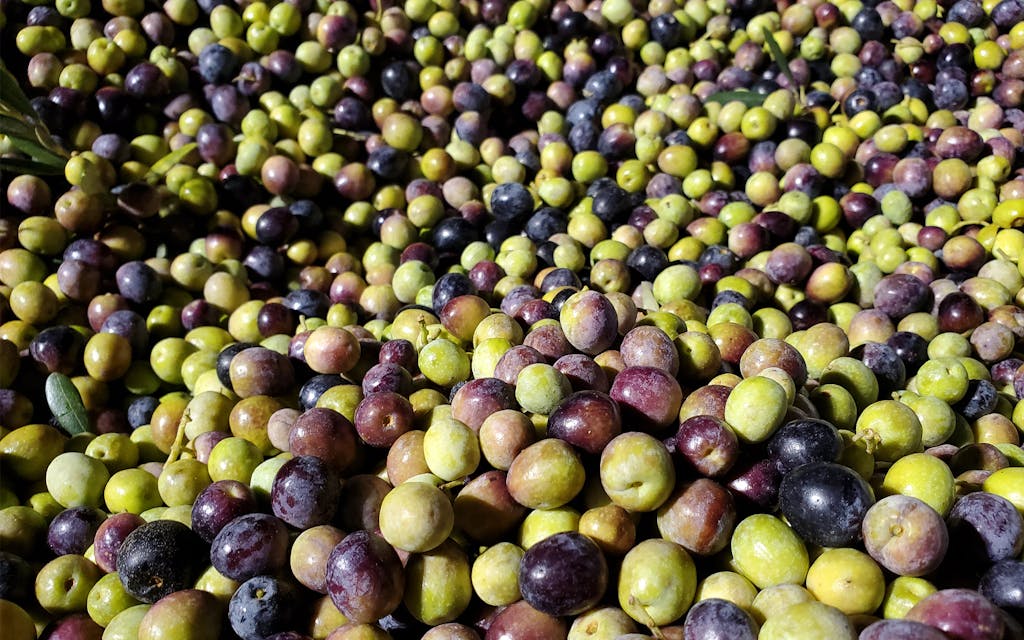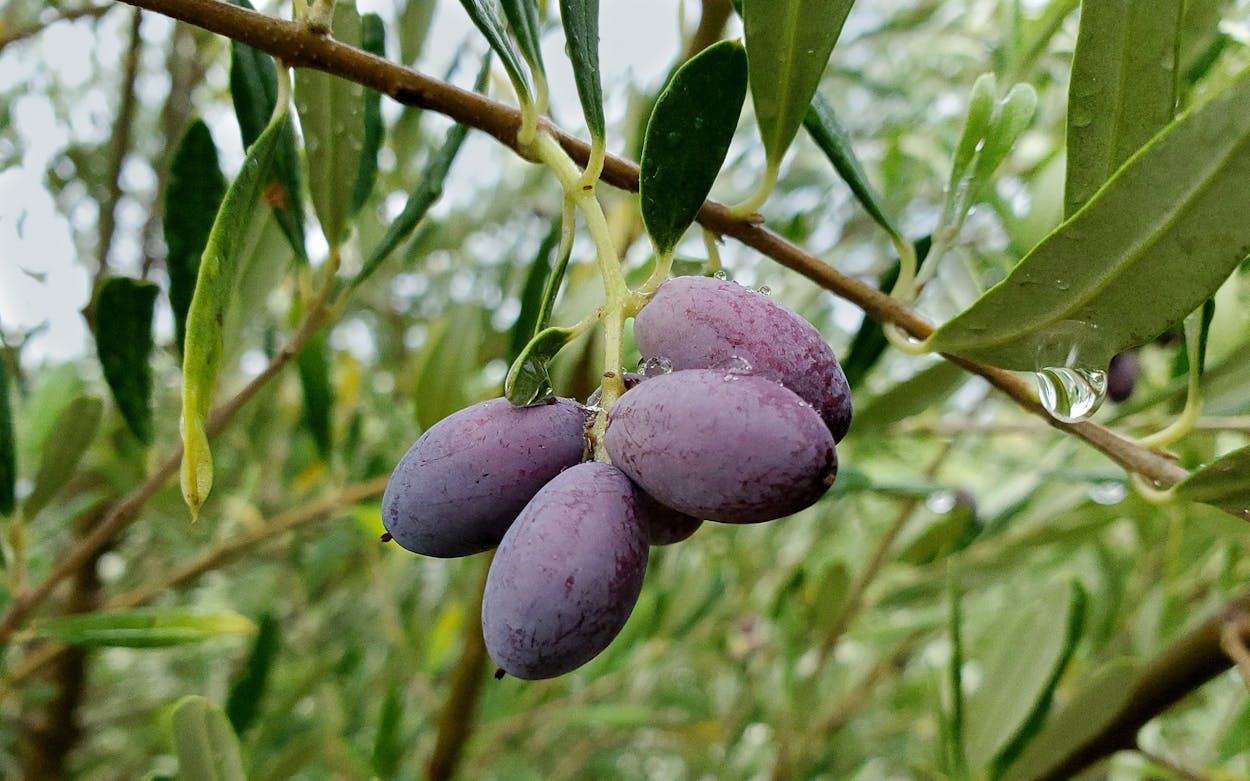In March 2021, Stephen Janak, a program specialist for Texas A&M AgriLife Extension Service, which provides research and training to growers across the state, drove across Texas, crisscrossing farm-to-market roads from Madisonville to Bandera. The previous year had seen a bumper crop of olives—the largest production year to date, the culmination of a decade-long boom in the Texas olive oil industry.
But as Janak visited growers—as he did regularly to check on variety trials—he saw fields full of dead trees. Instead of the shiny, green, feather-shaped leaves that had filled orchards only a month before, he saw acres and acres of brown. Winter Storm Uri had just gripped the state in a brutal and unrelenting cold, breaking records for the longest below-freezing streak in the state’s history. Olive orchards were decimated. The freeze reached so deep that the bark on some trees split open, like a wound. North of Interstate 10, Janak would discover that nearly every tree had frozen to the ground.
There hasn’t been an olive harvest in Texas since then. Subsequent freezes in 2022 and 2023, and now 2024, killed or damaged the young trees growers planted, which were more vulnerable to frost than mature trees. Now the Texas olive oil industry—once poised to compete with California’s for the massive American market—is in limbo. “The majority of the folks in the industry are in a wait-and-see mode,” Janak says. Most growers have scaled back their orchards, waiting to see how this winter unfolds. They aren’t managing or irrigating as intensively. Some have gotten out of the business entirely. Others have pivoted to importing oil from California or Europe.
“If you looked at olives in Texas at a three-year snapshot, it’d be really easy to say it’s not a viable crop in Texas,” says Michael Paz, the CEO of Texana Brands, a grower and miller with an orchard in South Texas. “People doing it are absolutely insane. But the truth is, once you get involved in olives, there is this thing that happens; it’s a passion thing. It’s a romance-with-this-plant thing.”
Paz and his family planted olive trees on two hundred acres in Artesia Wells, just north of Laredo, in 2012. The land had been in Paz’s wife’s family for generations, and the family wanted to do something more interesting than raising cattle or growing watermelons. What began as an experiment quickly became an obsession. “Olive oil is in the Bible. We created this; our hands, our people, our knowledge made it,” Paz says. “We made this green gold.” All the things that make growing olives in Texas challenging—extreme temperatures, drought, and deluges—are ultimately captured in the oil, he says, giving it a complex flavor profile, buttery with a kick at the end.


In 2021, when Paz heard that a freeze was coming, he did everything he could to protect his orchard. He irrigated heavily to insulate the trees and hired helicopters to fly over the orchard and push down warmer air. Texana’s trees survived. But three years and as many freezes later, the trees have yet to produce any olives.
The lack of production has forced growers to import olives from elsewhere to stay in business. When I talked to Paz, he was in Santa Margarita, California, harvesting olives. Texana has long operated an independent harvesting company that contracts with growers across the country. By 2022, with the oil supply exhausted, Paz started working with growers in California’s Central Valley to harvest and mill olives to sell under Texana Brands. The business changed its labels and product descriptions. “We’re still a Texas company,” Paz says. He’s clear that importing oil—even oil made from olives he mills and harvests himself—is a stopgap until the trees start bearing fruit again. If yet another year passes without a crop, he says, it’ll be time for some tough conversations about the future of the orchard. “I’ll always be in the industry,” he says. “We just might not farm olives in Texas.”
In 2020, at the height of the olive boom, Janak estimates almost two hundred producers were cultivating olives on 3,500 acres. Last year he sent a survey to sixty olive growers. Twenty percent said they had decided not to grow olives anymore.
Anyone who’s still selling olive oil in Texas has imported the olives from someplace else, says Michael Walzel, the president of the Texas Association of Olive Oil. The “GO TEXAN” label that adorns most Texas olive oil bottles—a program of the Texas Department of Agriculture to promote Texas-made products—requires only that a company has added value to a product in Texas (for example, by bottling or flavoring the olive oil).
Many producers have been transparent about this change. Lone Star Olive Ranch, one of the first commercial orchards in the state, lost nearly 14,000 trees during the 2021 freeze. “It will take time for our trees to grow and fruit,” wrote Cathy Bernell and Christine McCabe, the owners, on the company’s website. “Until then, all of our oils will come from groves we manage or . . . directly process for in California.” (Bernell didn’t respond to an interview request.)
Founded in 2016, the Texas Association of Olive Oil once counted fifty members. Today the membership has roughly halved, Walzel says. A retired chemical engineer, Walzel took over as president of the association earlier this year, after five of seven board members left the industry and resigned their seats. “Despite the complete loss of olives in the state of Texas for the last two years, the fortitude and determination shown by Texas olive growers have triggered the necessity of an active and visible Association,” wrote Bernell, then the board’s president, in an April letter. “Although the Association never truly went idle, we are ready to re-establish and work hand in hand with all Texas olive growers in the recovery and resurgence of the Texas Olive Industry.”
Before 1985, few Americans consumed olive oil in any real quantity. That year, a researcher at the University of Texas published a study in the Journal of Lipid Research that demonstrated the health benefits of monounsaturated fats, like those found in olive oil. “We began to reinvestigate olive oil some years ago because in the Mediterranean, olive oil is consumed in large amounts and there is no evidence that it’s harmful,” Scott Grundy, the UT professor, told the Washington Post in 1989. “In fact, people in southern Italy and Crete, where olive oil is consumed heavily, seem to be very healthy. They have very few heart attacks and not an excessive amount of cancer.”
As the health benefits became clear, olive oil consumption in the United States skyrocketed, more than quadrupling between 1990 and 2020. “The reason that people initially got into olive oil in Texas was it was a promising market,” Paz says. Only 5 percent of the olive oil consumed in the United States is produced domestically. Most of those olives were originally grown in California’s Central Valley, with its Mediterranean climate of dry summers and cool winters. The first olive trees were planted in Texas in the mid-1990s, but it wasn’t until 2010 that the industry really took off. By then, a few producers had demonstrated that olives could be a viable crop in Texas. In 2007, Texas Olive Ranch, in Carrizo Springs, had pressed the first commercial oil in the state.
But even before the 2021 freeze, growers struggled to adapt olives to Texas. “We’re growing a very, very Mediterranean crop in one of the most continental climates,” Paz says. “Olives don’t like a lot of rain. Well, some places in Texas it rains a hundred and twenty inches a year. Olives don’t like erratic temperature. Well, it’s ninety on Christmas and it’s negative thirteen in February.”
Olive trees grow best in a kind of Goldilocks zone, where it’s both hot and cold, but not too hot, and definitely not too cold. Like most stone fruit trees, olive trees require a certain number of chill hours, usually at temperatures ranging from 35 to 40 degrees, in order to flower and set fruit. But the trees can’t survive very long when the temperature dips below freezing. Accordingly, most olive growers in Texas are concentrated in a band stretching from north of Austin, near College Station, to south of San Antonio, near Carrizo Springs. “In Texas, at nighttime, it gets dark. Everywhere else at nighttime, it gets dark and cold,” Paz says. “And you really have to have those chill hours being uninterrupted to produce the way that you need to produce to run a viable olive-growing business.”
Walzel planted his first three thousand trees in an orchard near Navasota in 2020. Those trees flourished during the summer and fall—and then died during the freeze in February 2021. Undeterred, he planted new saplings again the following summer. They froze that winter. In 2022 he thought—“This will be my year.” Again, he watched as frost strangled all three thousand trees. “My wife thinks I’m crazy, if the definition of insanity is doing the same thing over and over and expecting different results,” he says. This year, he’s diversified, planting grapes alongside a scaled-back orchard of four hundred olive trees. But like many growers, he’s not ready to give up on olives.

Most olive trees grown in Texas are arbequina, a drought-resistant Spanish varietal. Janak wonders if there’s a cultivar better suited to Texas’s extreme weather. Because olives are some of the oldest cultivated plants in the world, there are hundreds of varieties, each one adapted to slightly different conditions. In 2015, researchers at Texas A&M AgriLife Extension planted nineteen olive varieties on test plots and farms across the state. Now Janak is working to establish a new variety trial, this time focusing on two qualities: freeze resistance and chill requirement. “I think there’s two ways that we go with olives in Texas,” he says. “Either we fix the freeze problem by a new cultivar or some management technique that we haven’t figured out yet, or we move them south, away from the freeze problem. But when we do that, we lose the chilling that’s needed to make them set fruit. So we have to find a variety that has a real low chilling requirement.”
It’s also possible that olives are simply too risky—too unreliable—to grow at a commercial scale in Texas. That was made clear last week, when a deep freeze gripped most of the state. “The outlook for a chance at actually producing any olive fruit in Texas in 2024 looks bleak once again,” Janak says. “It certainly could happen, and I’m holding my breath that some of them will make it through, but the odds are not good.”
At some point, Paz says, he might have to admit: “They don’t plant strawberries in Lubbock, Texas, for a reason, and maybe you don’t plant olives in South Texas for a reason. I’m not quite there yet, though,” he says. He suggests a title for this story: “Texas Olive Oil: The Slippery Romance.”
“There’s nothing like standing around the mill at harvest time and smelling fresh tons of olives being crushed right in front of you, then tasting the fresh oil,” Janak says. You do that once, he says, and you’re hooked. “The folks that are growing olives had a good summer,” Walzel says. “But summer is never our issue here in Texas. It’s always the wintertime.”






